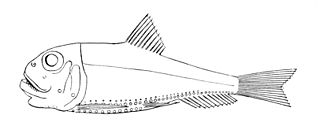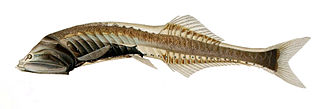
Stomiiformes is an order of deep-sea ray-finned fishes of very diverse morphology. It includes, for example, dragonfishes, lightfishes, loosejaws, marine hatchetfishes and viperfishes. The order contains 4 families with more than 50 genera and at least 410 species. As usual for deep-sea fishes, there are few common names for species of the order, but the Stomiiformes as a whole are often called dragonfishes and allies or simply stomiiforms.
The mesopelagiczone, also known as the middle pelagic or twilight zone, is the part of the pelagic zone that lies between the photic epipelagic and the aphotic bathypelagic zones. It is defined by light, and begins at the depth where only 1% of incident light reaches and ends where there is no light; the depths of this zone are between approximately 200 to 1000 meters below the ocean surface. It hosts a diverse biological community that includes bristlemouths, blobfish, bioluminescent jellyfish, giant squid, and myriad other unique organisms adapted to live in a low-light environment. It has long captivated the imagination of scientists, artists and writers; deep sea creatures are prominent in popular culture, particularly as horror movie villains.

The Gonostomatidae are a family of mesopelagic marine fish, commonly named bristlemouths, lightfishes, or anglemouths. It is a relatively small family, containing only eight known genera and 32 species. However, bristlemouths make up for their lack of diversity with numbers: Cyclothone, with 13 species, is thought to be the most abundant vertebrate genus in the world, numbering in the hundreds of trillions to quadrillions.

Fangtooths are beryciform fish of the family Anoplogastridae that live in the deep sea. The name is from Greek anoplo meaning "unarmed" and gaster meaning "stomach". With a circumglobal distribution in tropical and cold-temperate waters, the family contains only two very similar species in one genus, with no known close relatives.
Telescopefish are small, deep-sea aulopiform fish comprising the small family Giganturidae. The two known species are within the genus Gigantura. Though rarely captured, they are found in cold, deep tropical to subtropical waters worldwide.

Pelagic fish live in the pelagic zone of ocean or lake waters – being neither close to the bottom nor near the shore – in contrast with demersal fish that do live on or near the bottom, and reef fish that are associated with coral reefs.

Lightfishes are small stomiiform fishes in the family Phosichthyidae

The veiled anglemouth, Cyclothone microdon, is a bristlemouth of the family Gonostomatidae, abundant in all the world's oceans at depths of 300 – 2,500 meters. Its length is 10-15 cm though the largest known specimen is 7.6 cm (3 in). It gets its name from its circular mouth, filled with small teeth: the name “cyclothone” means in a circle or around and “microdon” means small teeth. The International Union for Conservation of Nature (IUCN) has assessed the veiled anglemouth is of Least Concern due to its abundance in most oceans and the little effect human impact has on its population growth. Some of the veiled anglemouth's physical features include a brown to black body with a radiating, or expansive, bioluminescent pigment over its head and fins.

Black seadevils are small, deepsea lophiiform fishes of the family Melanocetidae. The five known species are all within the genus Melanocetus. They are found in tropical to temperate waters of the Atlantic, Indian, and Pacific Oceans, with one species known only from the Ross Sea.
Vinciguerria is a genus of bristlemouths. It is named for Dr. Decio Vinciguerra (1856-1934), an Italian ichthyologist.

Cyclothone is a genus containing 13 extant species of bioluminescent fish, commonly known as 'bristlemouths' or 'bristlefishes' due to their shared characteristic of sharp, bristle-like teeth. These fishes typically grow to around 1-3 inches. They are most commonly found in the mesopelagic zone of the ocean, and are mostly found at depths of over 300 meters.
Cyclothone acclinidens, commonly known as the benttooth bristlemouth, is a species of ray-finned fish in the genus Cyclothone. It is found in the Atlantic, Pacific, and Indian Oceans.
Cyclothone alba, commonly known as the bristlemouth, is a species of ray-finned fish in the genus Cyclothone. It is found across the world, in the Pacific, Indian, and Atlantic Oceans.
Cyclothone braueri, commonly known as the garrick, is a species of ray-finned fish in the genus Cyclothone.
Cyclothone kobayashii, commonly known as the Kobayashi's bristlemouth, is a species of ray-finned fish in the genus Cyclothone. It is found in the Southern Ocean.
Cyclothone livida is a species of ray-finned fish in the genus Cyclothone. It is found in the Eastern Atlantic Ocean.
Cyclothone pallida, commonly known as the tan bristlemouth, is a species of ray-finned fish in the genus Cyclothone.
Cyclothone pallida, commonly known as the shadow bristlemouth, is a species of ray-finned fish in the genus Cyclothone.
Cyclothone pseudopallida, commonly known as the slender bristlemouth, is a species of ray-finned fish in the genus Cyclothone.







